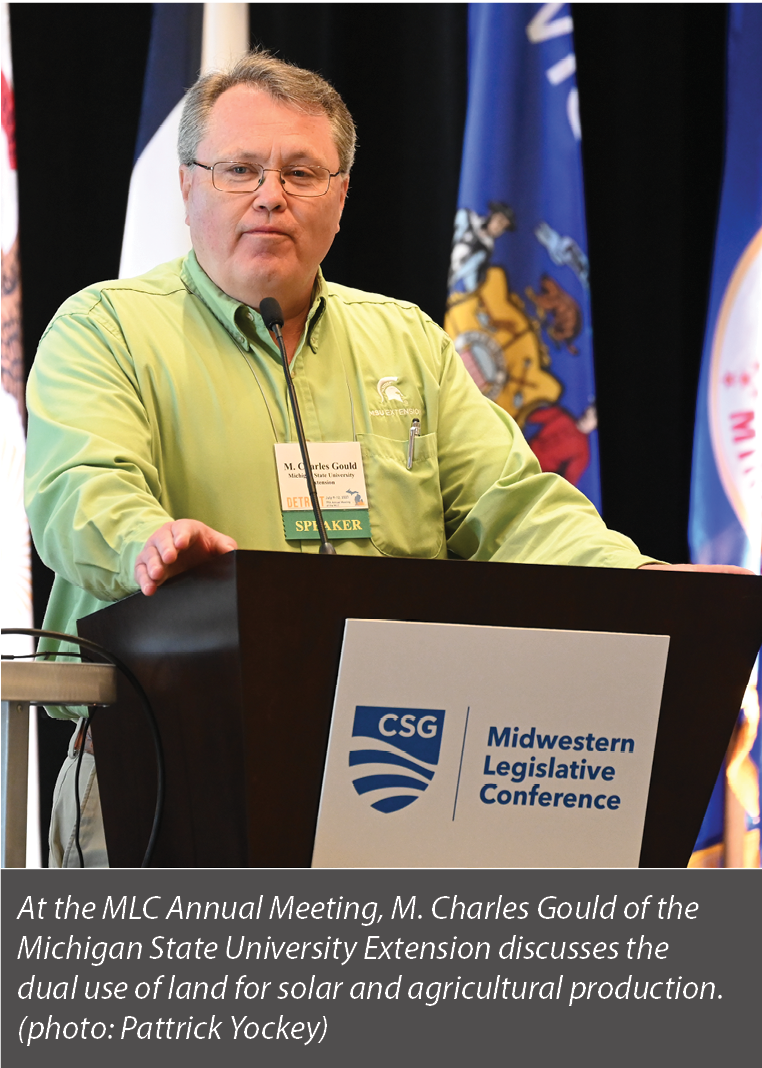As farmland comes under threat from development, ‘agrivoltaics’ is emerging as a potential option
 The excitement in the roomful of legislators was palpable when they got a glimpse into a future in which solar energy and crop production may be able to coexist on the same piece of agricultural land.
The excitement in the roomful of legislators was palpable when they got a glimpse into a future in which solar energy and crop production may be able to coexist on the same piece of agricultural land.
Presenter Charles Gould had shown them a picture of vertical bifacial solar arrays, an “upright” system that allows for solar production “between the rows” of working farmland. It’s a potential solution to an issue of concern for the Midwestern region: how to address the increased demand for solar power, which requires substantial amounts of land, while preserving farmland for food production.
With help from Gould and Kris Reynolds of the American Farmland Trust, state and provincial legislators explored this issue in July during a session at the Midwestern Legislative Conference Annual Meeting. The session was presented jointly by two MLC committees: Agriculture and Rural Affairs and Energy and Environment.
In the Midwest, farmland seems abundant. In actuality, it is a limited national resource. According to Reynolds, between 2001 and 2016, 11 million acres of U.S. farmland were converted to other uses, predominantly low-density housing due to population growth and urban sprawl. Some farmland, however, also is and will be used to produce renewable energy. (Many crops already are turned into energy products; most notably, 30 percent of all corn produced in the U.S. is used for ethanol.)
According to U.S. Department of Energy projections, ground-based solar could require about 0.5 percent of the land in the contiguous United States by 2050; that is about one-third of the size of Ohio.
But when this prediction was made, little did researchers know that engineers at various renewable energy companies were looking to reduce solar’s land footprint. When situated in an east/west configuration, vertical bifacial solar arrays can collect 27 percent more energy than traditional southfacing, slanted arrays, Gould said. That’s because energy production peaks twice a day for vertical arrays as they capture solar energy in the morning and evening. Peak production times neatly correlate with peak energy demands, Gould said.
Though more expensive than traditional solar arrays, vertical bifacial solar arrays collect less dust and snow, thereby increasing energy output, he added.
 Gould, a bioenergy educator at Michigan State University Extension, suggested that for farmers who don’t want their fields divided with solar energy systems, these systems could be used as pasture perimeters. Legislators are likely to hear more about these kinds of emerging products and technologies as they explore policies around “agrivoltaics” — the dual use of land for raising crops for food, fiber or fuel and for generating electricity.
Gould, a bioenergy educator at Michigan State University Extension, suggested that for farmers who don’t want their fields divided with solar energy systems, these systems could be used as pasture perimeters. Legislators are likely to hear more about these kinds of emerging products and technologies as they explore policies around “agrivoltaics” — the dual use of land for raising crops for food, fiber or fuel and for generating electricity.
This year, for instance, Colorado legislators passed a bill (SB 23-092) establishing new agrivoltaics-based property tax exemptions as well as a grant program to study the use of solar and farm production on the same land. Gould and Reynolds each offered their own policy ideas. Among them:
- Consider incentives for dual-use solar and agricultural production.
- Prioritize solar production on buildings or land not suitable for agriculture. However, don’t limit production to non-agricultural areas: Many farmers welcome the stability of revenue from solar production.
- Design laws and regulations in a way that allow for changes in technology and flexibility in system design.
- Ensure under-served communities are fully represented in decision-making.
- Map your state’s agricultural land and plan for agriculture, not just around it.
- Safeguard your state’s most productive land and invest in purchase of agricultural conservation easements (PACE), which keep this land from being taken out of production for other uses.